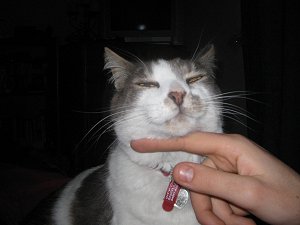What's in it for the cat? De-stressing studies of cat-human relationships.

Scientists and psychologists agree that interaction with a cat can have a very positive effect on the physiological and psychological well-being of humans. They tell us that people who frequently pet their cats have lower stress levels and reduced blood pressure. Having a friendly feline around can speed up recovery from a variety of health problems. Older people who adopt cats tend to be healthier in the first place. At the other end of the age spectrum, cats are frequently used as helpers in therapy with autistic children. So it is clear - cats are good for us, mentally and physically. But do we reciprocate? Do cats get any psychological benefits from hanging around with humans, or are they just in it for the regular dinners?
Actually it turns out that petting a cat is not just good for humans, it also has medical benefits for the cat. Veterinarians at the Cornell Feline Health Center tested a cat's blood pressure following petting. They attached a small pressure cuff to a cat's leg and checked the blood pressure after different lengths of petting. After being stroked for five minutes blood pressure dropped by 25 points, indicating the cat was calmer and less stressed.
In another experiment a scientist at the Honolulu Zoo measured cortisol levels in cats. Cortisol is a hormone which increases under stress. Over time, high cortisol levels weaken the immune system and make a cat (or human) more prone to illness. All the cats in this experiment were well socialized, which means that they found being stroked more relaxing than stressful. They were put into two groups. One group received the usual amount of petting and being talked to. The other group of cats was left with minimal human interaction. The results showed that cats which found that they now had much less interaction with humans became stressed, as shown by their increased cortisol level. In other words, the cats were actually missing human company, even though the food kept coming on a regular basis.
In another experiment cortisol levels were measured after a stressful procedure; in this case when a catheter had to be inserted into cat's leg. A well-socialized cat which was petted during the procedure had an almost unchanged level of cortisol. However, cats which were not socialized and cats that were not petted had higher cortisol levels. In other words this proves scientifically what most people with cats already know - petting a cat during an unpleasant experience helps calm the cat. However, they probably don't know that the petting actually helps the cat's health.
So if petting a cat relaxes both human and cat, what's the cat's favourite? Drs. Susan Soennichsen and Arnold Chamove from the University of Massey in New Zealand carried out experiments to find where cats most enjoyed being petted. (Yup - your research dollars at work, folks!) For most cats the answer is stroking at the side of the head between the eyes and the ears. The cats probably prefer this area because a major scent gland is located there, and it enables the cat to deposit her scent on the hand of the person stroking.
But remember - as if you could ever forget - that every cat is an individual, and stroking heaven for one cat might be an impermissible invasion of privacy for another. Also cats like routine, so many cats prefer to be stroked or petted at a particular time of the day or in a particular place. For example a cat might prefer that you do your stroking behind the ears while the cat is sitting on her favourite rug. Cats are masters at training their people, so let the cat teach you what she likes most and you both will get the maximum health benefit from your friendship.
